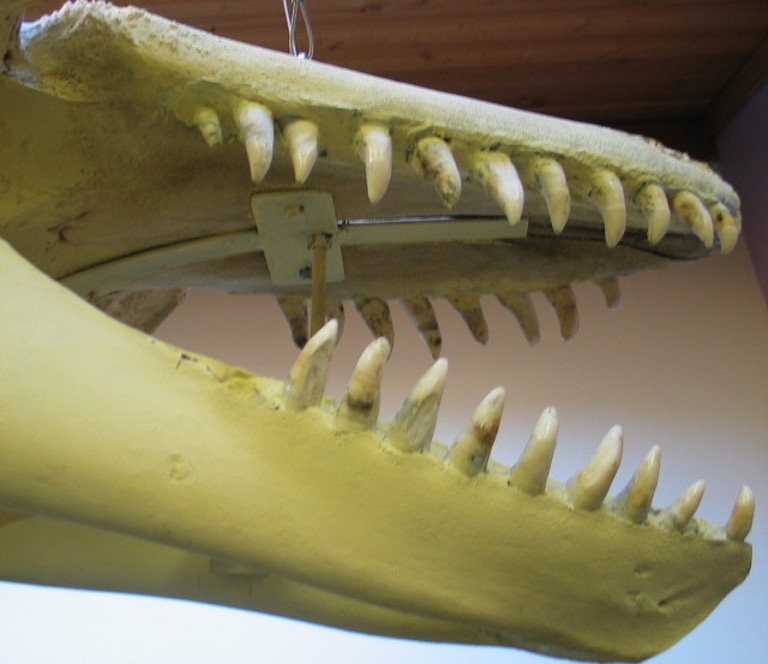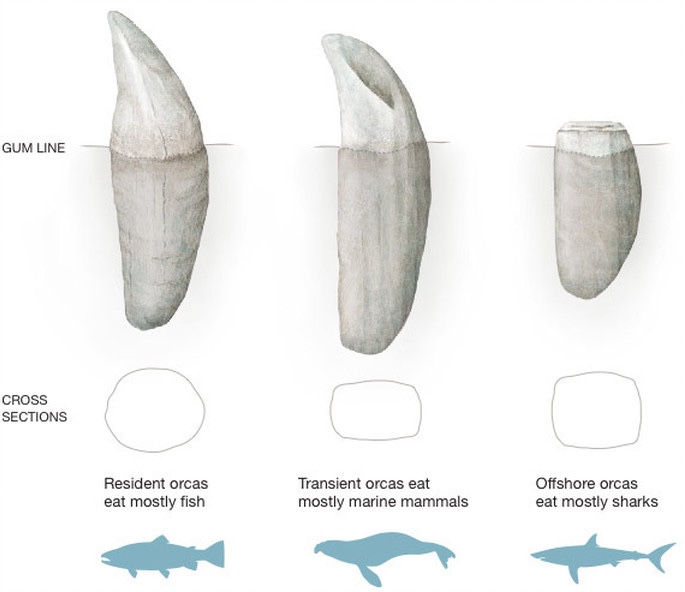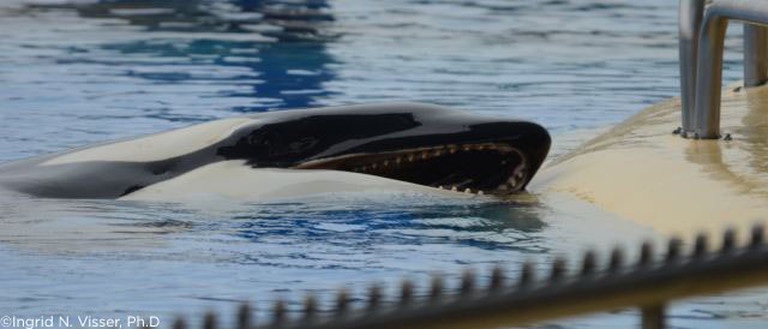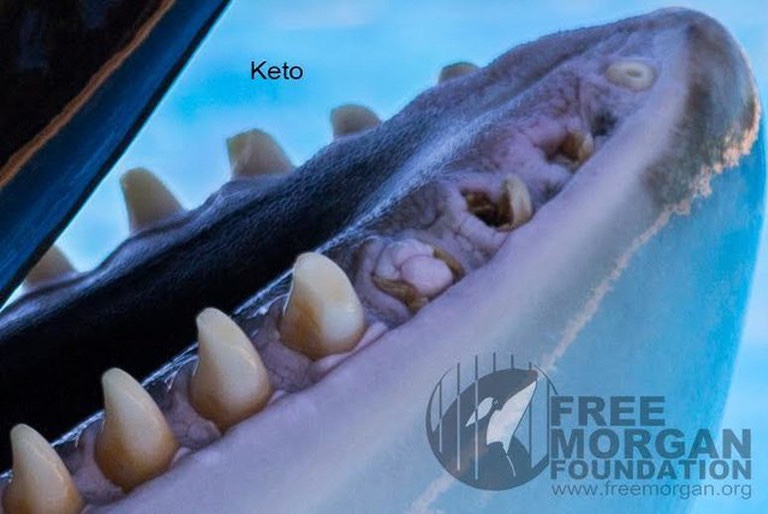Adult killer whales have one set of 40-56 interlocking teeth (usually 10 to 14 teeth along each side of each jaw) which can grow up to four inches long. Conical in shape, these fearsome teeth are used to grip and tear prey into smaller pieces perfect for swallowing, as orcas do not chew their food. Robust and highly durable, orca teeth are designed to last a lifetime and are not replaced once lost.

Photo via TheOrcaProject.
However, due to the handling of prey, wild orca teeth can become worn and degrade over the course of numerous decades. Although it’s a gradual process, some populations and eco-types are more susceptible to tooth wear, or oral degradation, than others. Tooth wear in Type 1 North Atlantic killer whales is associated with suction feeding – a specialised feeding method used by this population to consume stunned fish during carousel feeding – whereas the slight tooth wear of Pacific transient teeth is associated with their predation on marine mammals. North-eastern Pacific offshore orcas are the most susceptible to severe tooth wear due to their predation of sharks. Frequently tearing the shark’s rough skin during hunting can wear the teeth down to the gum, although severe cases are usually seen in older orca. Overall, tooth wear in wild orcas is attributed to prey type or feeding type, not to the manipulation of objects in their environment.

As the diet of all captive orcas consists of thawed frozen fish, which is directly placed into their mouths by their trainers, attributed causes of oral degradation in wild orcas do not apply to their captive counterparts. Rather than prey/feeding type, it’s the confined conditions imposed upon orcas in captivity which are directly responsible for tooth wear. In confinement, it’s common for separated orcas to bite down on horizontal metal bars, or to “jaw-pop” through the gates as they display aggression at each other. In addition, under-stimulated and bored animals also “chew” metal bars and mouth concrete pool corners, like the main stages and concrete slide outs.

Photo via Ingrid Visser for the Free Morgan Foundation.
Consequently, teeth can become broken or fractured, with tooth fragments occasionally littering the bottom of the pools following these displays. This breakage leaves the pulp of some teeth exposed which allows for decay, causing a cavity that then leads to food plugging. If left untreated the orcas own immune system will create inflammation and eventually a focus for systemic infection.

Photo via the Free Morgan Foundation.
To try and avoid infection, captive orcas are subjected to painful dental procedures during which holes are drilled into their teeth (pulpotomy) using a variable speed drill. The holes are then flushed 3 times a day. The whole procedure is performed without pain relief causing the orcas to suffer in great discomfort. During the procedures, orcas often squeal, shudder and sink away from the person performing the procedure. Watch Kayla having her teeth flushed below:
A former SeaWorld trainer commented on the process: “The whales are conditioned to “accept” the noise, heat, vibration and obvious pain associated with drilling vertically through the tooth column and into the fleshy pulp below. Success is measured by blood spilling out of the hole, in which case it’s apparent the bore is complete.” The chronic pain caused by poor dental health causes captive orcas to participate in the destructive behaviour of grinding down the jaw itself leaving the orca with little or no teeth.

Photo provided by Holly C.
In the wild, tooth breakage is exhibited very rarely and the wearing of teeth occurs over the course of decades. In captivity, almost every orca has drilled, severely worn or missing teeth with significant damage occurring at a rapid rate in some cases. For example, Makaio, who resides at SeaWorld Orlando, had at least 5 teeth drilled in his lower left jaw by the age of 3. A 2011 court testimony by SeaWorld’s vice president of veterinary services, Dr. Chris Dold, revealed 14 of the 20 orcas at SeaWorld (at the time) required daily anti-septic flushes of their drilled teeth.
Additionally, according to SeaWorld’s 2010 killer whale profiles, various animals had significant dental issues. Edited by The Orca Project, they are as follows:
Living:
Tuar, M, 10 — 14 drilled teeth, another is cracked and he has worn his lower teeth from extensive rubbing and picking at paint at the bottom of the pools.
Keet, M, 17— Dental work done on 11 teeth and missing part of another.
Kyuquot, M, 18— No teeth drilled- small chip on one. Extensive erosion and yellowing of lower teeth and back upper teeth at and below the gum line.
Orkid, F,21— Had one tooth removed in 1995.
Katina, F, 34— Two badly chipped teeth and another broken at the base.
Corky II, F, 45— Worn teeth on lower and upper jaw. Many decayed and discoloured.
Deceased:
Kayla, F, 21— 12 of her teeth drilled, another is cracked, and one is missing.
Kasatka, F, 34— Missing three teeth on the lower back right jaw.
Unna, F, 13— Nine teeth drilled. Wear on lower teeth.
Kalina, F, 23— Four teeth pulled, five drilled.
Taima, F, 20— Seven teeth under dental care, three removed.
A 2016 study by Ingrid N. Visser and Rosina B. Lisker revealed severe tooth wear in all of SeaWorld’s orcas at Loro Parque, with between 41.66% and 75% of their lower jaw teeth being ‘moderately or severely’ damaged’.
Since these recordings, it’s highly likely that the condition of these orca’s remaining teeth continued to degrade. However, as of 2015, SeaWorld has moved away from performing pulpotomy procedures on their orcas and are now allowing a natural barrier called an ‘epithelial cap’ (a natural bodily response produced by the animal when their pulp cavity becomes exposed) to form over the broken/eroded tooth/teeth to help protect the site from infections and debris. Revealed by Animal and Plant Health Inspection Service (APHIS) inspector Dr. R. Brandes, SeaWorld changed their dental practices after consulting a human dentist and a veterinary dentist and are now actively increasing the amount of enrichment and trainer interactions in an effort to prevent dental issues, which the inspector admits are “long-standing” at SeaWorld Orlando and have been “observed for many years”.
Although SeaWorld has moved away from pulpotomy procedures, the vast majority of marine parks and aquariums continue to actively use these practices on their captive orcas.
*Note: In November 2017, SeaWorld transferred ownership of its orcas in Spain to Loro Parque.